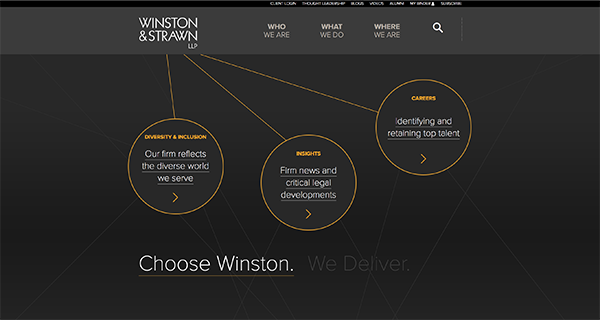The rise of intelligent site search
Have you recently wondered: What happened to those corner-screen search fields?
You may have noticed that tiny search fields previously tucked away in the corner are now showcased prominently in the main navigation of modern websites. Whether it's a big magnifying glass or similar large search field, it's clear that site search has come to the forefront of web design.

Websites previously relied on a standard navigation system to show all sections of the site at once. Contemporary sites are taking a different approach by showcasing only the most important buckets of content in the main navigation, leaving subordinate sections to footer or interior page navigations.
This change has occurred for a few different reasons:
-
Widespread mobile/tablet device browsing lends itself to a continuous-scroll user experience via longer web pages, shifting the focus from a single navigation point to several.
-
Mobile/tablet adoption has also led to new responsive layouts that feature search as a primary means of navigation.
-
Website analytics provide details on the most widely used portions of a website, which now includes search.
-
Everyday web users are more sophisticated than ever before and value browsing efficiency. Search is often the quickest way to find what you are looking for on a large-scale website.
A well-architected advanced site search is even faster to find what you're looking for. Major advancements in search technologies over the years have allowed web developers to hone in on search queries and refine search results better than ever.
Site search was previously often focused on webpage name (e.g., Contact Us, Privacy Policy, etc.) or content and keywords contained in the webpage. Now, though, users can enjoy an enhanced experience by accessing hordes of other data, and more importantly that data's relationship to other associated data.
Leveraging Related Content
Modern content management systems, like RubyContent and industry-focused versions like RubyLaw, utilize a 360° data relationship module, to link different data together. For example, law firms using RubyLaw can easily relate a lawyer to a practice area, a publication, an office, and various other data types. When a user searches for that lawyer on the public website, they'll receive a link to their bio as well as links to their related practices, publications, office(s), etc.
To take this a step further, the 360° data is also reciprocal so that when a practice is searched for, visitors will receive a list of lawyers, publications, and office(s) in the results; likewise for other searches and other related data.
Search configuration can be customized for each client to account for unique data and relationships. A well executed site search coupled with intelligent data relationships will allow users to easily surface content they want and the related content you want them to see.

